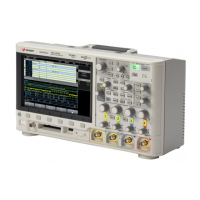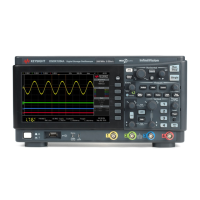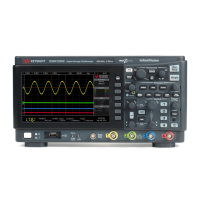Do you have a question about the Keysight DSOX3054T and is the answer not in the manual?
| Bandwidth | 500 MHz |
|---|---|
| Channels | 4 |
| Sample Rate | 5 GSa/s |
| Memory Depth | 4 Mpts |
| Waveform Update Rate | 1, 000, 000 waveforms/sec |
| Vertical Resolution | 8 bits |
| Connectivity | USB, LAN, GPIB (optional) |
| Input Coupling | AC, DC, GND |
| Timebase Range | 2 ns/div to 1000 s/div |
| Display Type | LCD |
| Display Size | 12.1 in |
| Input Impedance | 1 MΩ |
| Interface | USB, LAN, GPIB (optional) |
| Maximum Input Voltage | 300 Vrms |
| Trigger Types | Edge, Pulse Width, Pattern |
| Operating Temperature | 0 to 50 °C |
| Display | 12.1-inch capacitive touch display |
Details on power requirements, ventilation, and how to power on the oscilloscope.
Steps to connect oscilloscope probes to the channel BNC connectors and probe tips.
Automatically configure the oscilloscope to best display the input signals.
How to adjust the time/div setting using the horizontal scale knob.
Procedure to adjust the horizontal delay (position) knob to move the trigger point.
Adjusting the vertical scale (volts/division) using the knob above the channel key.
Moving the waveform up or down on the display using the small vertical position knob.
Procedure for connecting digital probes to the device under test.
Adjusting waveform intensity using the Entry knob to account for signal characteristics.
Adjusting the trigger level for analog channels using the Trigger Level knob.
Identifying triggers by specified edge (slope) and voltage level on a waveform.
Triggering on a positive or negative pulse of a specified width.
Identifying a trigger condition by looking for a specified pattern of channel states.
Triggering on setup and hold violations.
Capturing complicated waveforms of standard analog video signals.
Selecting the trigger mode to control oscilloscope behavior when triggers are not occurring.
Setting the time the oscilloscope waits after a trigger before re-arming the circuitry.
Using the Run/Stop and Single keys to start and stop oscilloscope acquisition.
Choosing acquisition modes: Normal, Peak Detect, Averaging, High Resolution.
Using cursors to make custom voltage, time, phase, or ratio measurements.
Using the Meas key to display the Measurement Menu and add measurements.
Defining vertical levels for measurements on analog channels or math waveforms.
Configuring the oscilloscope to display a golden waveform and create a mask.
Using the DVM analysis feature for 3-digit voltage measurements on analog channels.
Using the counter analysis feature for frequency, period, or edge event measurements.
Setting up and running the Frequency Response Analysis (FRA) feature.
Accessing the Waveform Generator Menu and selecting waveform types.
Saving oscilloscope setups, screen images, and acquired waveform data.
Recalling saved setups, mask files, or arbitrary waveform data.
Printing the complete display, including status line and softkeys, to a USB or network printer.
Configuring remote access via USB device port, LAN interface, or other I/O interfaces.
Setting up the oscilloscope's LAN connection for network access.
Assigning common, repetitive actions to the Quick Action key.
Connecting to the oscilloscope's LAN and accessing its web interface.
Connecting to CAN signals and specifying source, threshold, baud rate, and sample point.
Setting up triggers for CAN version 2.0A, 2.0B, and CAN FD signals.
Setting up CAN serial decode to capture and decode CAN/CAN FD data.
Connecting to LIN signals and specifying source, threshold, baud rate, and sample point.
Setting up LIN serial decode to capture and decode LIN data.
Connecting to FlexRay signals and specifying source, threshold, baud rate, and bus type.
Setting up triggers on FlexRay frames, errors, or events.
Setting up FlexRay serial decode to capture and decode FlexRay signals.
Connecting to I2C signals and specifying source, threshold, and address.
Triggering on I2C conditions like Start/Stop, Restart, or EEPROM Data Read.
Setting up I2C serial decode to capture and decode I2C data.
Connecting to SPI signals and specifying clock, MOSI, MISO, and framing.
Triggering on SPI data patterns at the start of a frame.
Setting up SPI serial decode to capture and decode SPI signals.
Connecting to I2S signals and specifying clock, word select, and data lines.
Triggering on I2S signals based on data values or qualifier conditions.
Setting up I2S serial decode to capture and decode I2S data.
Connecting to Manchester-encoded serial bus signals and specifying configuration.
Setting up Manchester triggers based on start of frame or value.
Setting up Manchester serial decode to capture and decode Manchester signals.
Connecting to NRZ-encoded serial bus signals and specifying configuration.
Setting up NRZ triggers based on start of frame or value.
Setting up NRZ serial decode to capture and decode NRZ signals.
Connecting to MIL-STD-1553 signals and specifying source and threshold voltage levels.
Setting up MIL-STD-1553 triggers on data words or errors.
Setting up MIL-STD-1553 serial decode to capture and decode MIL-STD-1553 signals.
Connecting to ARINC 429 signals and specifying source, threshold, baud rate, and bus type.
Setting up ARINC 429 triggers on words, labels, or errors.
Connecting to SENT signals and specifying source, threshold, and bus configuration.
Connecting to UART/RS232 signals and specifying source, mode, and parameters.











